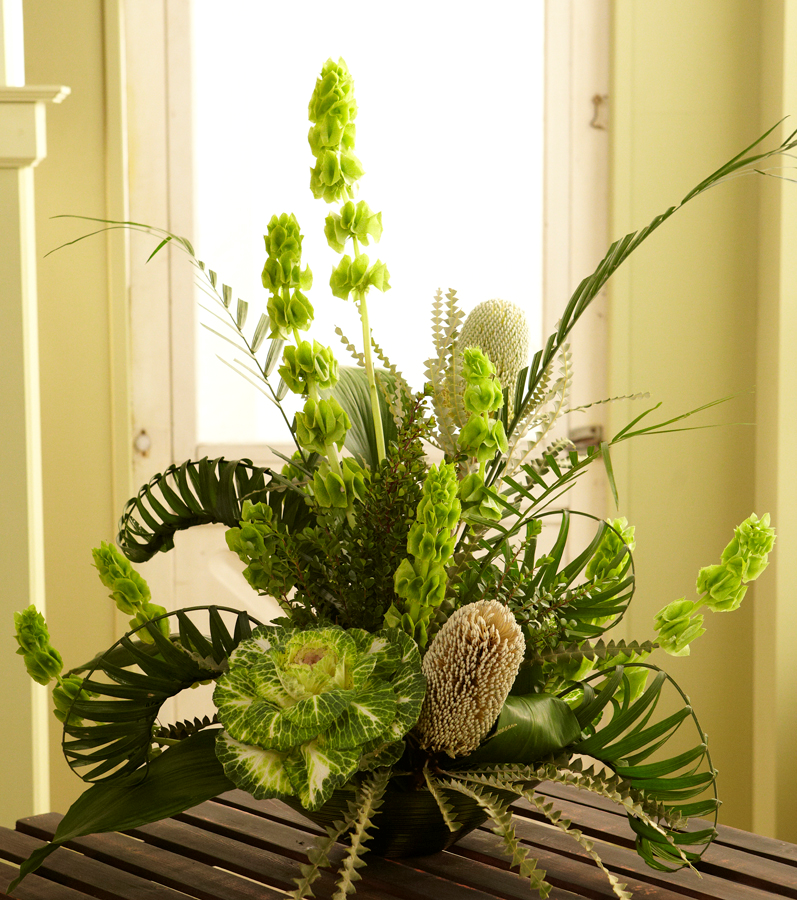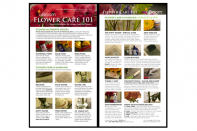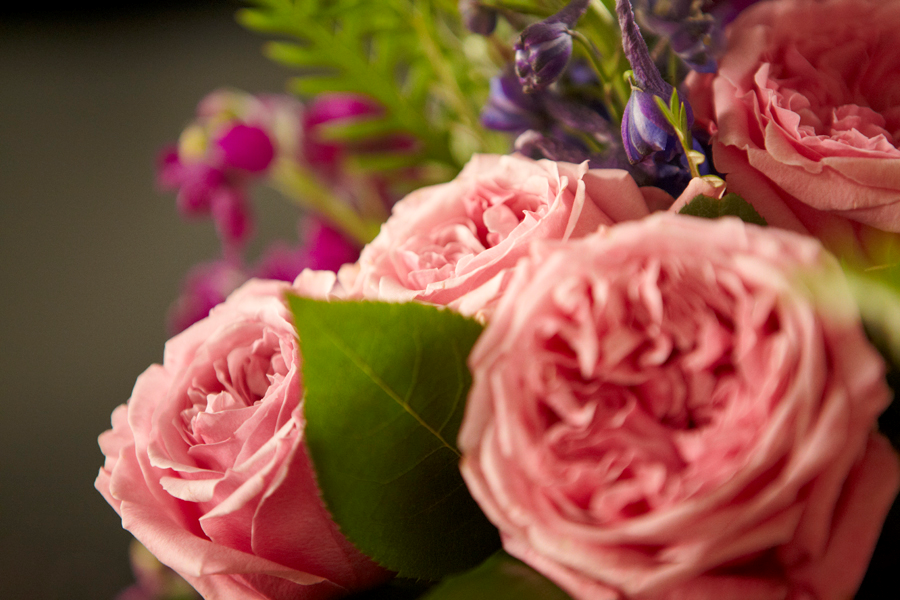2012 AUGUST NEWSLETTER: Gay Smith
 “Good swiping is an art in itself” Jules Feiffer“Every good idea I’ve ever had, I’ve stolen from someone else,” announced a manager during a sales meeting. I laughed with the group, but it got me thinking about how often we re-create a wheel that’s already well-greased and turning. Flower handling is a good example. In the past decade, many best practices and protocols have been developed at Universities and among the flower chemical company with proven results, but too often, shops utilize handling methods based on urban legends rather than implementing proven protocols. One of the most striking developments in the supermarket world of flowers is their commitment to specific care and handling protocols and best practices. Do they do everything right? No! But their size and scope demand the implementation of set protocols as a way of reducing waste and maximizing flower quality for consumers…the very same goals every retail flower shop embraces. Poor prep and sloppy handling bite into profits regardless of size.Controlling waste is critical to GP when your product is highly perishable. Implementing specific handling protocols puts teeth into your waste control program. Start at point of purchase: is your supplier on top of temperature management? Ask what steps they do to respect the cold chain. Temperature is tantamount to maximizing vase life. With every ten degree rise in temperature (°C) on the front end of transport, holding, processing and reselling to you, at least a day of vase life is lost in the consumer’s home.Best handling protocols means everyone handles flowers the same way. Correct handling eliminates the guess-work, saves labor hours and reduces shrink. Make temperature and correct solution use primary targets. Cooler set-point is 34-38F (85% humidity) for everything except tropical blooms. Tropicals store no colder than 50F. Get flowers info the cooler ASAP to reduce stress. Stress bites into overall vase life! Don’t let wholesale deliveries sit out in back room—if you cannot process immediately, at least place the packages in the cooler. Once flowers are cold, keep them cold to reduce development of condensation on blooms. Remember to prepare solutions with cold water as another way of reducing condensation. Even a micro-film of water is sufficient for spores of the ubiquitous fungus and lover of all flowers and fruits, Botrytis, to start developing. Don’t rely solely on the wall thermometer, check temperature of cooler bucket for a more accurate reading. Don’t forget to look at your compressor coils. If they are covered with gobs of dust, your cooler is not running efficiently.
“Good swiping is an art in itself” Jules Feiffer“Every good idea I’ve ever had, I’ve stolen from someone else,” announced a manager during a sales meeting. I laughed with the group, but it got me thinking about how often we re-create a wheel that’s already well-greased and turning. Flower handling is a good example. In the past decade, many best practices and protocols have been developed at Universities and among the flower chemical company with proven results, but too often, shops utilize handling methods based on urban legends rather than implementing proven protocols. One of the most striking developments in the supermarket world of flowers is their commitment to specific care and handling protocols and best practices. Do they do everything right? No! But their size and scope demand the implementation of set protocols as a way of reducing waste and maximizing flower quality for consumers…the very same goals every retail flower shop embraces. Poor prep and sloppy handling bite into profits regardless of size.Controlling waste is critical to GP when your product is highly perishable. Implementing specific handling protocols puts teeth into your waste control program. Start at point of purchase: is your supplier on top of temperature management? Ask what steps they do to respect the cold chain. Temperature is tantamount to maximizing vase life. With every ten degree rise in temperature (°C) on the front end of transport, holding, processing and reselling to you, at least a day of vase life is lost in the consumer’s home.Best handling protocols means everyone handles flowers the same way. Correct handling eliminates the guess-work, saves labor hours and reduces shrink. Make temperature and correct solution use primary targets. Cooler set-point is 34-38F (85% humidity) for everything except tropical blooms. Tropicals store no colder than 50F. Get flowers info the cooler ASAP to reduce stress. Stress bites into overall vase life! Don’t let wholesale deliveries sit out in back room—if you cannot process immediately, at least place the packages in the cooler. Once flowers are cold, keep them cold to reduce development of condensation on blooms. Remember to prepare solutions with cold water as another way of reducing condensation. Even a micro-film of water is sufficient for spores of the ubiquitous fungus and lover of all flowers and fruits, Botrytis, to start developing. Don’t rely solely on the wall thermometer, check temperature of cooler bucket for a more accurate reading. Don’t forget to look at your compressor coils. If they are covered with gobs of dust, your cooler is not running efficiently. When it comes to solution preparation, it’s critical to mix according to manufacturers’ directions. Efficacy of the solution is all about the correct ratio of clarifiers, nutrients and acidifiers. Overdosing wastes money. Under-dosing results in a bacteria soup, fast. Properly mixed solutions are active for 3-4 days at room temp and 5-6 days in the cooler. Reusing cooler processing solutions all week is OK, but do skim out green bits between flower loads. Using solutions for entire “active” period is economically sustainable and helps conserves water. One method to achieve correct dosing is attaching an injector system which automatically mixes the concentrate with water. Another idea is using Chrysal T-bags, pre-measured doses of display solution. Develop a simple flow chart to avoid confusion. Use photos of various bucket sizes marked with a strip of masking tape that indicates the fill level and the corresponding amount of flower food needed.Five solution rules to post in processing area1. Start with clean buckets2. Measure when mixing to get the dose right3. Use cold water (flows faster and prevents excessive condensation inside bunches)4. Measure when adding ice (so as NOT to dilute the formula),5. Never pour old solutions together or into fresh solution.Best practices have to include sanitation codes of practice. These COP’s focus on frequency and correct cleaning solution. Want more bang for your elbow grease? Use a flower-specific cleaner like Chrysal Cleaner rather than bleach to scrub away gunk and greasy scum bacteria produce. Chlorine is a contact germicide which means it is rendered “in-active” once it attacks scum or bacteria. Chrysal Cleaner formula contains a soap to loosen grease and scum from scratches inside buckets and not only cleans and sanitizes, it provides residual protection. Prepare a spray bottle with Chrysal cleaner (1 capful/liter) and spray choppers, cutters and work tables liberally during the day to prevent cross contamination. No need to rinse or dry surfaces; in fact let the Cleaner provide residual protection. Frequency is key in any sanitation program. Spray tools and tables 2-3 times daily; wipe shelves at least weekly and scrub floors monthly. Weekly, dump spent bucket cleaning solution into trash cans and let sit for 10 minutes. Dip brooms into this solution to kill the bacteria and Botrytis spores hiding on the bristles.
When it comes to solution preparation, it’s critical to mix according to manufacturers’ directions. Efficacy of the solution is all about the correct ratio of clarifiers, nutrients and acidifiers. Overdosing wastes money. Under-dosing results in a bacteria soup, fast. Properly mixed solutions are active for 3-4 days at room temp and 5-6 days in the cooler. Reusing cooler processing solutions all week is OK, but do skim out green bits between flower loads. Using solutions for entire “active” period is economically sustainable and helps conserves water. One method to achieve correct dosing is attaching an injector system which automatically mixes the concentrate with water. Another idea is using Chrysal T-bags, pre-measured doses of display solution. Develop a simple flow chart to avoid confusion. Use photos of various bucket sizes marked with a strip of masking tape that indicates the fill level and the corresponding amount of flower food needed.Five solution rules to post in processing area1. Start with clean buckets2. Measure when mixing to get the dose right3. Use cold water (flows faster and prevents excessive condensation inside bunches)4. Measure when adding ice (so as NOT to dilute the formula),5. Never pour old solutions together or into fresh solution.Best practices have to include sanitation codes of practice. These COP’s focus on frequency and correct cleaning solution. Want more bang for your elbow grease? Use a flower-specific cleaner like Chrysal Cleaner rather than bleach to scrub away gunk and greasy scum bacteria produce. Chlorine is a contact germicide which means it is rendered “in-active” once it attacks scum or bacteria. Chrysal Cleaner formula contains a soap to loosen grease and scum from scratches inside buckets and not only cleans and sanitizes, it provides residual protection. Prepare a spray bottle with Chrysal cleaner (1 capful/liter) and spray choppers, cutters and work tables liberally during the day to prevent cross contamination. No need to rinse or dry surfaces; in fact let the Cleaner provide residual protection. Frequency is key in any sanitation program. Spray tools and tables 2-3 times daily; wipe shelves at least weekly and scrub floors monthly. Weekly, dump spent bucket cleaning solution into trash cans and let sit for 10 minutes. Dip brooms into this solution to kill the bacteria and Botrytis spores hiding on the bristles. Ethylene exposure is another shrink buster that can be reduced when you start asking questions and setting up in-shop protocols. Ask suppliers if blooms are STS-treated when ordering e-sensitive varieties like aconitum, sweet peas, lysimachia, alstroemeria and snaps. If wax blooms litter the design table, the agapanthus arrive with blooms in bottom of the box or delphiniums rain petals, you are seeing symptoms of ethylene exposure. This gas is colorless and odorless (non-toxic to humans and animals), but very damaging in minute amounts to flowers. The symptoms of exposure are easy to recognize: white cut dendrobiums shriveling, turning a weird chartreuse color (all orchids, cut and potted, are highly sensitive to ethylene exposure). Asiatic lily buds shriveling and falling off stems, florets of physostegia, aconitum and asclepias shattering all over the floor, distorted bloom opening, transparent petals, bluish discoloration--all examples of ethylene exposure. Sensitive cuts need to be treated immediately after harvest (at farm level) because damage from ethylene is irreversible, but often doesn’t show up until several days down the chain. Sensitive potted plants (Kalanchoe, hibiscus, spaths, begonias) need to be treated with anti-ethylene gas either during transport or box by box with use of ethylene buster sachets. At shop level, keep all food out of flower coolers, avoid drifting cigarette smoke from patio area into back room and make sure delivery vans don’t exhaust into the shop during the loading process. Set a hard rule of no smoking in delivery vans.Another “steal-able” idea comes from plant nurseries. Granted it is more focused on marketing than care and handling, but worth considering--using sign language to stimulate flower interest. Price signage is tantamount, but how about details on correct home care, vase life expectations and best display locations. Flower origin also stimulates sales interest. Clever signage gives consumers ideas of how flowers can articulate feelings they are struggling to put into words. A few years back, Sun Valley Floral launched a campaign playing off an idea “stolen” from an advert on a non-floral product. The campaign utilized research data amassed on the emotional and health benefits of flowers (http://www.aboutflowers.com) and included point of purchase materials highlighting flower power with one of three slogans: Feel Great! Feel Happy! Feel Better!When it comes to stealing ideas, keep your radar detector on high, give credit where credit is due, and have fun bending another’s idea to fit your need!. !.
Ethylene exposure is another shrink buster that can be reduced when you start asking questions and setting up in-shop protocols. Ask suppliers if blooms are STS-treated when ordering e-sensitive varieties like aconitum, sweet peas, lysimachia, alstroemeria and snaps. If wax blooms litter the design table, the agapanthus arrive with blooms in bottom of the box or delphiniums rain petals, you are seeing symptoms of ethylene exposure. This gas is colorless and odorless (non-toxic to humans and animals), but very damaging in minute amounts to flowers. The symptoms of exposure are easy to recognize: white cut dendrobiums shriveling, turning a weird chartreuse color (all orchids, cut and potted, are highly sensitive to ethylene exposure). Asiatic lily buds shriveling and falling off stems, florets of physostegia, aconitum and asclepias shattering all over the floor, distorted bloom opening, transparent petals, bluish discoloration--all examples of ethylene exposure. Sensitive cuts need to be treated immediately after harvest (at farm level) because damage from ethylene is irreversible, but often doesn’t show up until several days down the chain. Sensitive potted plants (Kalanchoe, hibiscus, spaths, begonias) need to be treated with anti-ethylene gas either during transport or box by box with use of ethylene buster sachets. At shop level, keep all food out of flower coolers, avoid drifting cigarette smoke from patio area into back room and make sure delivery vans don’t exhaust into the shop during the loading process. Set a hard rule of no smoking in delivery vans.Another “steal-able” idea comes from plant nurseries. Granted it is more focused on marketing than care and handling, but worth considering--using sign language to stimulate flower interest. Price signage is tantamount, but how about details on correct home care, vase life expectations and best display locations. Flower origin also stimulates sales interest. Clever signage gives consumers ideas of how flowers can articulate feelings they are struggling to put into words. A few years back, Sun Valley Floral launched a campaign playing off an idea “stolen” from an advert on a non-floral product. The campaign utilized research data amassed on the emotional and health benefits of flowers (http://www.aboutflowers.com) and included point of purchase materials highlighting flower power with one of three slogans: Feel Great! Feel Happy! Feel Better!When it comes to stealing ideas, keep your radar detector on high, give credit where credit is due, and have fun bending another’s idea to fit your need!. !.

